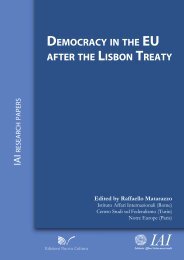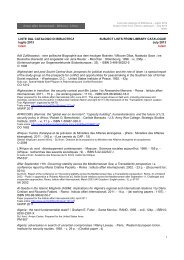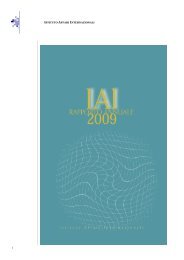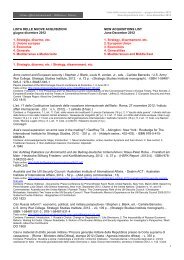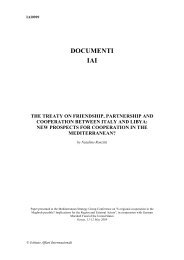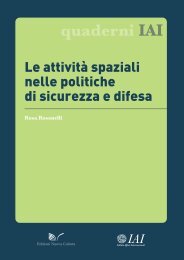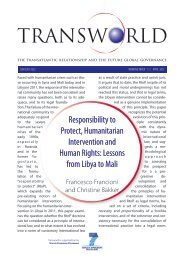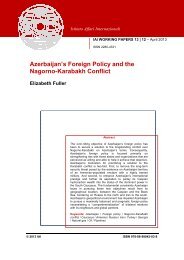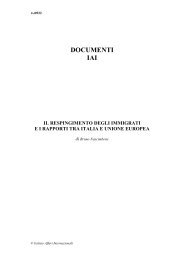La minaccia NBCR - Istituto Affari Internazionali
La minaccia NBCR - Istituto Affari Internazionali
La minaccia NBCR - Istituto Affari Internazionali
You also want an ePaper? Increase the reach of your titles
YUMPU automatically turns print PDFs into web optimized ePapers that Google loves.
Terrorist Incidents > by Region Range: 01/01/1968 - 01/21/2008<br />
Region Incidents Injuries Fatalities<br />
Africa 1172 9757 3715<br />
East & Central Asia 242 5584 253<br />
Eastern Europe 1510 5151 2010<br />
<strong>La</strong>tin America & the Caribbean 3683 4029 2369<br />
Middle East / Persian Gulf 15121 59731 29554<br />
North America 588 4344 3568<br />
South Asia 5178 23556 8871<br />
Southeast Asia & Oceania 1891 5810 2043<br />
Western Europe 5558 5678 1441<br />
TOTAL 34943 123640 53824<br />
E quali siano le tattiche usate negli atti di terrorismo, con particolare riferimento alle minacce<br />
non convenzionali 18 :<br />
Terrorist Incidents > by Tactic Range: 01/01/1968 - 01/21/2008<br />
Tactic Incidents Injuries Fatalities<br />
Armed Attack 8156 14994 13660<br />
Arson 1092 332 382<br />
Assassination 2498 1447 3208<br />
Barricade/Hostage 211 2221 903<br />
Bombing 19683 100204 29704<br />
Hijacking 233 377 482<br />
Kidnapping 2355 210 1608<br />
Other 180 447 167<br />
Unconventional Attack 64 3024 3047<br />
Unknown 471 384 663<br />
TOTAL 34943 123640 53824<br />
Per l’Italia riportiamo la scheda dell’attacco non convenzionale (agenti chimici) che nel 1988<br />
colpì, senza vittime, la distribuzione alimentare e delle acque: “Other Group attacked Food or<br />
Water Supply target (Apr. 25, 1988, Italy) - (…) - Description: ITALY. The Organization of<br />
Metropolitan Proletariat and Oppressed Peoples, a group claiming support for the Palestinian<br />
uprising in the West Bank, notified authorities that it had injected poison into grapefruits<br />
18 Secondo la descrizione dei curatori del database: “(…) CBRN: Chemical, Biological, Radiological and<br />
Nuclear. Chemical weapons are commonly divided into 4 major categories. Choking agents, blood agents,<br />
blister agents and nerve agents. Many of these chemical agents are needed in mass quantities in order to kill<br />
large groups, and for this reason they are generally not chosen by terrorists as a means of infecting en masse.<br />
Biological weapons involve the purchase or theft of a biological agent, such as a virus, and the subsequent<br />
transformation of the agent into an easily disseminated substance, such as a gas or a powder. While it is<br />
generally believed to be fairly simple to acquire a biological agent, it is rather difficult to store many of these<br />
toxins, and even more complex to convert them into a state which can readily infect a large group. Radiological<br />
weapons are used to attack victims by exposure to a radioactive material (such as iridium-192). The victims<br />
must come in rather close contact with the weapon (i.e., touch, inhalation or ingestion) in order for the radiation<br />
to kill the body's cells. Nuclear weapons present the "easiest" way to ensure the death of large groups of people;<br />
however, the problems in acquiring a nuclear weapon make it nearly impossible for terrorists to choose them as<br />
an option.(…)”, RAND - MIPT Terrorism knowledge base,, http://www.tkb.org/RandSummary.jsp?page=about<br />
- 9 -





